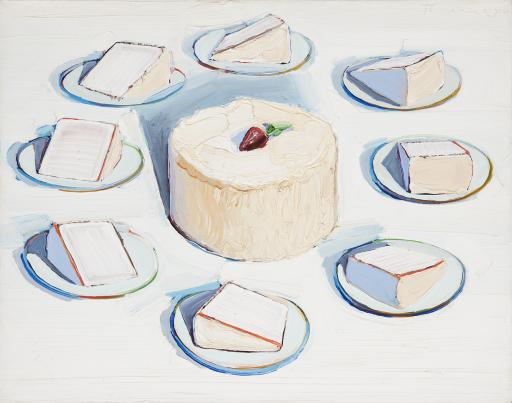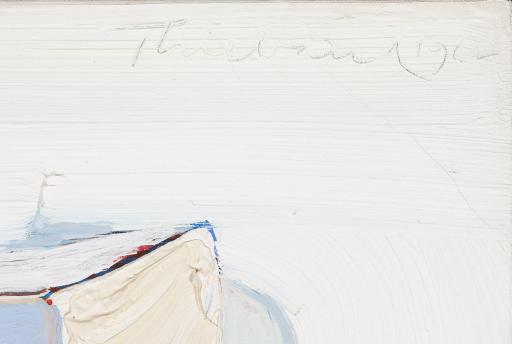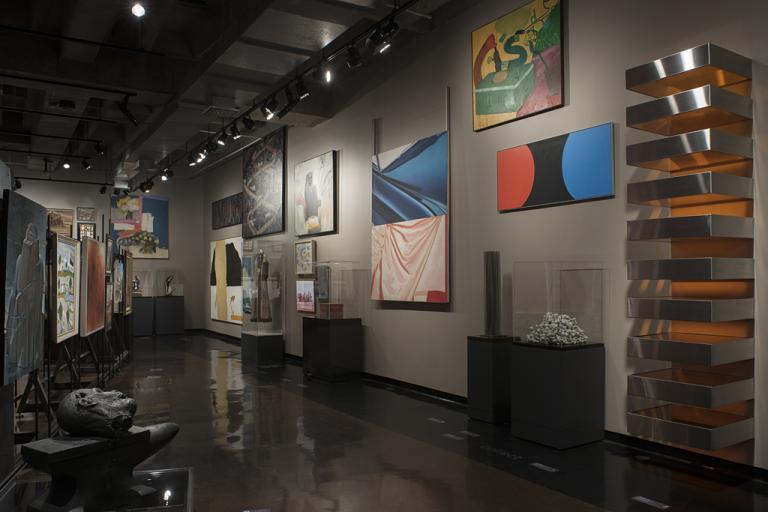Around the Cake, Wayne Thiebaud
Artwork Overview
Canvas/Support (Height x Width x Depth): 55.9 x 71.1 cm
Canvas/Support (Height x Width x Depth): 22 x 28 in
Frame Dimensions (Height x Width x Depth): 23 1/2 x 29 5/8 x 2 1/2 in
If you wish to reproduce this image, please submit an image request
Images
Label texts
Wayne Thiebaud drew inspiration from mass-produced objects and commercial food displays, making his works relatable to consumers and art lovers alike. This painting presents an indulgently frosted cake encircled by similar cake slices, as if on display in a supermarket or bakery. Intense shadows and vibrant colors mimic advertisements of the 1950s and 1960s while the heavily applied paint provides an illusion of realistic, thick frosting, which the artist described as a kind of metaphor for American overindulgence.
Wayne Thiebaud’s painting of cake reflects his interest in mass-produced and widely available American consumer goods such as desserts, often opulently displayed in diner and cafeteria cases. Here the cake comes whole or by the slice, with all the decadent frosting anyone could want.
Wayne Thiebaud’s painting of cake reflects his interest in mass-produced and widely available American consumer goods such as desserts, often opulently displayed in diner and cafeteria cases. Here the cake comes whole or by the slice, with all the decadent frosting anyone could want.
Click on the audio tab above to listen to a student's interpretation of this object.
Wayne Thiebaud, a painter usually classified as Pop, began painting mass-produced foodstuffs in the 1950s. Prior to his painting career he was a commercial artist. Thiebaud, who considers himself more realist that Pop, paints common American edibles - pies, cakes, hotdogs, ice cream cones, -- which he says, “every American child has been brought up on.” He presents his subject with deadpan repetition, again a blank background, to demonstrate “how much alike yet how different an image can be.”
Thiebaud works in an improvisational manner, creating each painting quickly from his imagination. Fascinated with Jasper John’s interplay between illusion and reality, Thiebaud playfully reconstructs the look and feel of real cake frosting. Of such creamy confections the artist says: “The decoration in Europe, particularly of cakes, seems more delicate. Here they are full of globs of material such as chocolate and cream. The materials are used as a kind of metaphor of plentitude. Americans always put on much more frosting, etc. than is needed.”
Wayne Thiebaud, a painter usually classified as Pop, began painting mass-produced foodstuffs in the 1950s. Prior to his painting career he was a commercial artist. Thiebaud, who considers himself more realist that Pop, paints common American edibles - pies, cakes, hotdogs, ice cream cones, -- which he says, “every American child has been brought up on.” He presents his subject with deadpan repetition, again a blank background, to demonstrate “how much alike yet how different an image can be.”
Thiebaud works in an improvisational manner, creating each painting quickly from his imagination. Fascinated with Jasper John’s interplay between illusion and reality, Thiebaud playfully reconstructs the look and feel of real cake frosting. Of such creamy confections the artist says: “The decoration in Europe, particularly of cakes, seems more delicate. Here they are full of globs of material such as chocolate and cream. The materials are used as a kind of metaphor of plentitude. Americans always put on much more frosting, etc. than is needed.”
Wayne Thiebaud, a painter usually classified as Pop, began painting mass-produced foodstuffs in the 1950s. Prior to his painting career he was a commercial artist. Thiebaud, who considers himself more realist that Pop, paints common American edibles - pies, cakes, hotdogs, ice cream cones, -- which he says, “every American child has been brought up on.” He presents his subject with deadpan repetition, again a blank background, to demonstrate “how much alike yet how different an image can be.”
Thiebaud works in an improvisational manner, creating each painting quickly from his imagination. Fascinated with Jasper John’s interplay between illusion and reality, Thiebaud playfully reconstructs the look and feel of real cake frosting. Of such creamy confections the artist says: “The decoration in Europe, particularly of cakes, seems more delicate. Here they are full of globs of material such as chocolate and cream. The materials are used as a kind of metaphor of plentitude. Americans always put on much more frosting, etc. than is needed.”
Wayne Thiebaud, a painter usually classified as Pop, began painting mass-produced foodstuffs in the 1950s. Prior to his painting career he was a commercial artist. Thiebaud, who considers himself more realist that Pop, paints common American edibles - pies, cakes, hotdogs, ice cream cones, -- which he says, “every American child has been brought up on.” He presents his subject with deadpan repetition, again a blank background, to demonstrate “how much alike yet how different an image can be.”
Thiebaud works in an improvisational manner, creating each painting quickly from his imagination. Fascinated with Jasper John’s interplay between illusion and reality, Thiebaud playfully reconstructs the look and feel of real cake frosting. Of such creamy confections the artist says: “The decoration in Europe, particularly of cakes, seems more delicate. Here they are full of globs of material such as chocolate and cream. The materials are used as a kind of metaphor of plentitude. Americans always put on much more frosting, etc. than is needed.”
Archive Label 2009:
Wayne Thiebaud, a painter usually classified as Pop, began painting mass-produced foodstuffs in the 1950s. Prior to his painting career he was a commercial artist. Thiebaud, who considers himself more realist that Pop, paints common American edibles - pies, cakes, hotdogs, ice cream cones, -- which he says, “every American child has been brought up on.” He presents his subject with deadpan repetition, again a blank background, to demonstrate “how much alike yet how different an image can be.”
Thiebaud works in an improvisational manner, creating each painting quickly from his imagination. Fascinated with Jasper John’s interplay between illusion and reality, Thiebaud playfully reconstructs the look and feel of real cake frosting. Of such creamy confections the artist says: “The decoration in Europe, particularly of cakes, seems more delicate. Here they are full of globs of material such as chocolate and cream. The materials are used as a kind of metaphor of plentitude. Americans always put on much more frosting, etc. than is needed.”


























